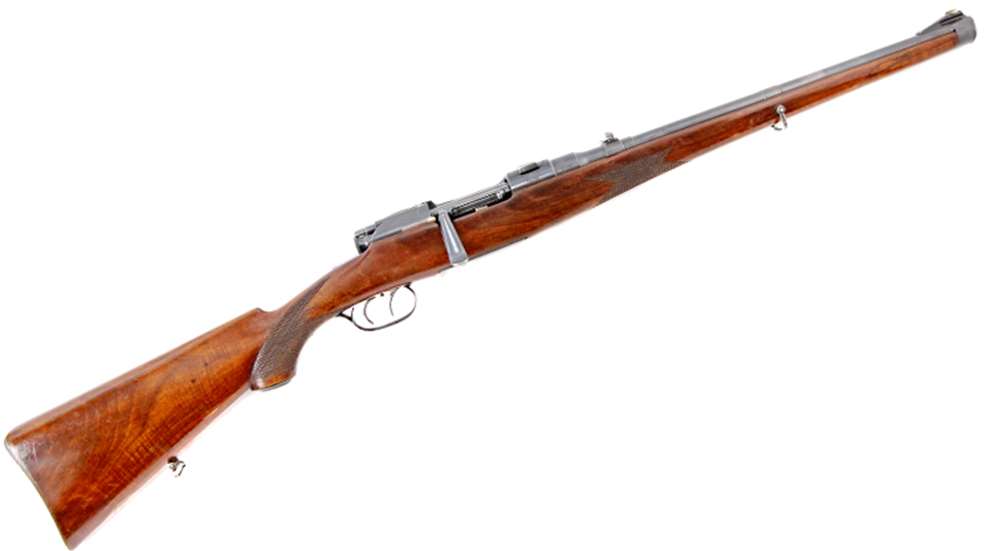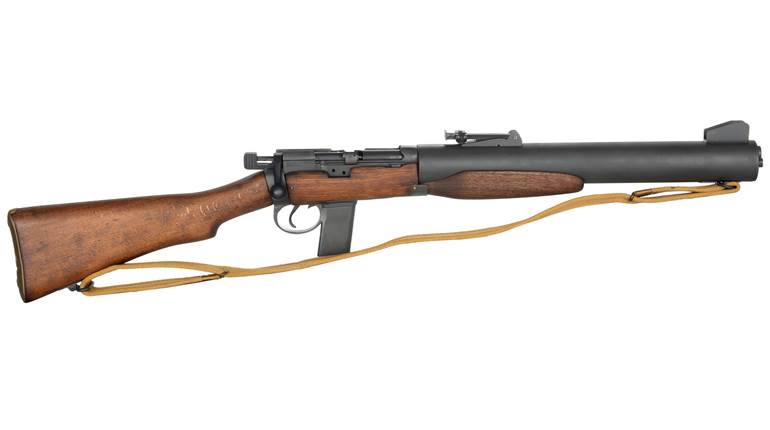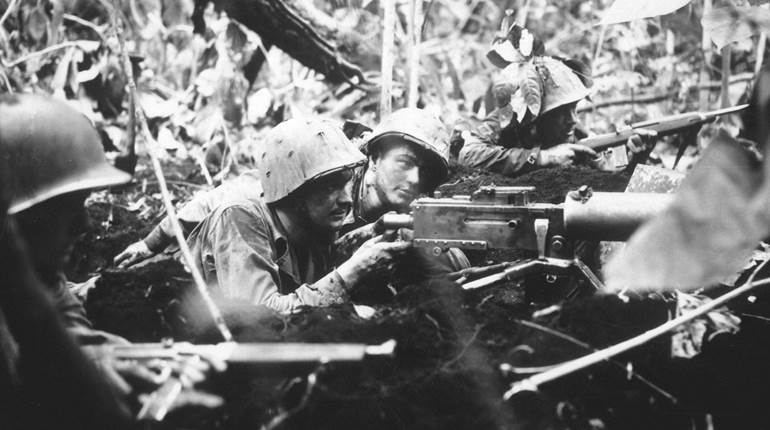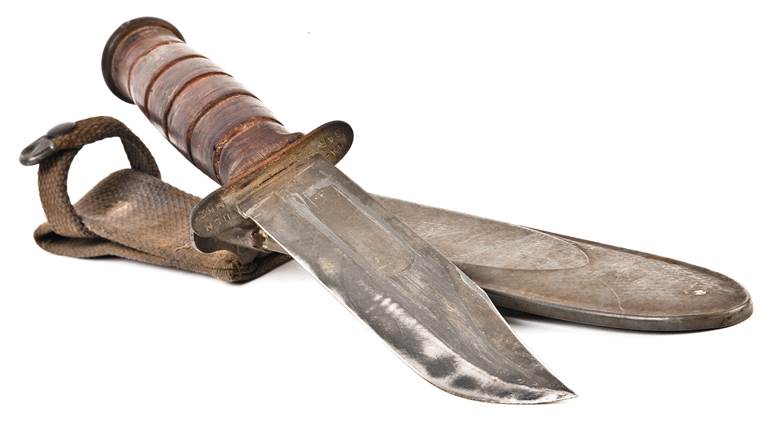
By the time Hemingway got his hands on a Mannlicher-Schoenauer in 1930, the rifle’s basic design was nearly half-a-century old, its roots going back to one of the first turnbolt rifle designs, the Dreyse Needle Gun. The needle gun, and its successor the Mauser Model 1871, used a split-bridge receiver through which the breech bolt handle passed when the action was worked. Paul Mauser’s 1871 bolt design used a separate head with a wing safety mounted at the rear, features that found their way onto the later Mannlichers.
In the 1880s a commission of Prussian officers designed what European firearms expert Ludwig Olson said “sired” the later Mannlicher turnbolt rifles. The Gewehr 1888 “Commission” rifle drew its inspiration from both Mauser and Mannlicher innovations. While the action resembled the 1871 Mauser, the rifle used Ferdinand von Mannlicher’s en bloc clip for cartridge feeding.
The aesthetics of the 1888 also contributed to later Mannlicher-Schoenauers. Carbines produced for cavalry units that featured “stutzen” stocks that terminated in a metal cap at the muzzle. The style was common on compact European military carbines and was designed to protect their lightweight barrels. While the handle on early turnbolt military rifles was often a round knob that protruded out at a 90 degree angle, the bolt on the ’88 carbine featured a turned down and flattened, or “spatulated,” handle that made the carbine more compact for carry in a scabbard.
The immediate evolution of the Commission rifle was Mannlicher’s Model 1891. While Mauser’s designs went to a solid rear receiver bridge with the bolt handle located behind it and a box magazine, Mannlicher stuck to the split-rear-bridge receiver and en bloc clip. The rifle was adopted by the armies of Romania in 1892 and the Netherlands in 1895.
A decade after Mannlicher’s first turnbolts appeared, the rifle that would be known as the Mannlicher-Schoenauer came on the scene. Patented in 1900, it differed from previous Mannlichers in its magazine, doing away with the en bloc clip and replacing it with a rotary design by Steyr employee Otto Schönauer (a name often Anglicized as “Schoenauer”). The rifle was originally designed as a military arm, tested and rejected by Portugal, but accepted by Greece in 1903. Only 300,000 of the military rifles would be manufactured over the following three decades as Greece was the only army to accept the design.
While the Mannlicher-Schoenauer failed as a military rifle for economic reasons (it cost nearly twice as much as contemporary Mausers), it found success in the sporting world. Though limited numbers of commercial rifles had been built on the 1900 action, it wasn’t until 1903 that production was standardized.
The classic 1903 carbine has a 450 mm (17.7") barrel—a common length for European cavalry carbines—in a slender profile that approximates a modern No. 1. It was stocked to the muzzle, an aesthetic that the rifle made so iconic that to this day such a stock is known simply as a “Mannlicher.” The entire package had an overall length just under 40" and weighed about 6 lbs. For the American shooter, the compactness and handiness of the 1903 carbine is most similar to that of a Winchester Model 94, which along with the Mannlicher-Schoenauer are what Jeff Cooper said inspired his scout rifle concept. Though most famous in its carbine form, Steyr also made a long-barreled, half-stocked rifle version.
One can only imagine what went through the mind of the tanned and scarred professional African hunter when he was first handed a Mannlicher-Schoenauer over the counter of a Nairobi sporting goods store. At the turn of the century such a man would have been experienced using single-shot falling-block or double rifles that weighed more than 8 lbs. and fired a cartridge propelled by blackpowder or cordite with a solid-lead, paper-patched bullet weighing 300 grs. or more at velocities under 2000 f.p.s.
The Mannlicher was one of the first of the small-bore, bolt-action repeaters that would turn the sporting world on its ear. The 1898 version of the British Encyclopedia of Sport stated that the 6.5 and .303 “have effected a revolution in game shooting.” Like earlier Mannlicher turnbolts the Mannlicher-Schoenauer became popular with fine English gunsmiths, from Gibbs to Holland & Holland, who built custom guns on both military and commercial actions in carbine, rifle and takedown forms.
The success of the 1903 Mannlicher-Schoenauer spawned a line of Steyr-built rifles, each sized for a proprietary cartridge that included 8x56 mm, 9x56 mm and 9.5x57 mm offerings. In 1924 a standard-size action was introduced for the .30-’06 Sprg., 8x57 mm and other popular commercial rounds.
Production of Steyr’s Mannlicher-Schoenauer was interrupted by World War II. When it resumed after the war all rifles were based on two action sizes, the pre-war “standard” 1924 and a magnum size. The standard action was chambered for a variety of cartridges, including those popular in the North American market, like .270 Win. and .243 Win., and the magnum accommodated then-new belted rounds, including .338 Win. Mag. and .458 Win. Mag. Attempts were made to update the design for the needs of the modern rifleman who used telescopic sights. Though a split-bridge receiver is a notoriously difficult design to accommodate scopes, Steyr drilled its rifles for side mounts, swept back and dished out bolt handles to clear scope tubes, added side safeties and gave its stocks Monte Carlo cheekpieces to bring a shooter’s eyes in line with high-mounted optics.
Despite updates in design and styling, by the 1960s the Mannlicher-Schoenauer was succumbing to the same economic pressures that stymied its military sibling. The complicated machining and hand-fitting that economically doomed the rifle as a military arm spelled the demise of the turn-of-the-century design as a sporting firearm. The last of the Mannlicher Schoenauers were built in the late 1960s with rifles still being assembled from parts into the early ’70s. It was one of the last classic firearms that went out of production following World War II and marked the end of an era of hand-built factory guns.
From the pages of American Rifleman, read In Pursuit of A "Really Good Rifle": The 1903 Mannlicher-Schoenauer Carbine





































